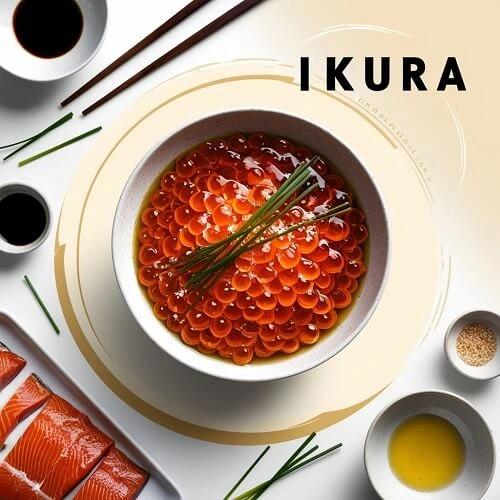Making ikura at home might sound like a task best left to professional chefs, but with this beginner-friendly ikura recipe, it’s much easier than you think! This guide will walk you through simple steps to transform fresh salmon roe into a delectable Japanese delicacy. Whether you’re looking to elevate your sushi game, prepare a stunning rice bowl, or explore new culinary creations, this recipe ensures success every time. With a handful of ingredients and a little patience, you’ll have a batch of ikura that’s bursting with flavor and perfect for any occasion. Ready to get started? Let’s dive in!
What is Ikura?
Ikura, a Japanese delicacy, refers to salmon roe—bright orange pearls bursting with briny flavor. This iconic ingredient is a staple in Japanese cuisine, celebrated for its rich taste and vibrant appearance.
Origins of Ikura
Japanese Cuisine and the Art of Fish Roe
Ikura has deep roots in Japanese culinary traditions, often used as a topping for sushi, rice bowls, and more. The meticulous preparation reflects the artistry of Japanese cooking.
Global Appeal of Ikura
Today, Ikura’s popularity extends beyond Japan, finding its way into gourmet dishes worldwide. Its unique flavor and aesthetic charm make it a favorite for chefs and food enthusiasts alike.
Why is Ikura Popular?
Ikura’s popularity isn’t just about its visual appeal. Its flavor, health benefits, and versatility have made it a culinary superstar.
Nutritional Benefits of Ikura
Rich Source of Omega-3 Fatty Acids
Ikura is a powerhouse of omega-3 fatty acids, which are essential for heart and brain health. These healthy fats also contribute to glowing skin and improved cognitive function.
Packed with Essential Vitamins
In addition to omega-3s, ikura contains vitamins A, D, and E, along with antioxidants. These nutrients support the immune system, promote eye health, and fight off free radicals.
Versatility in Dishes
From traditional Japanese meals to modern fusion recipes, ikura can elevate any dish. Its ability to blend with various flavors and cuisines makes it a favorite among chefs and home cooks alike.
How to Select Quality Ikura
Selecting high-quality ikura ensures the best flavor and texture for your dishes.
Freshness Matters
Checking Color and Texture
Fresh ikura should be bright orange and slightly translucent. The texture should feel firm and plump, not mushy or overly dry.
Where to Buy the Best Ikura
Look for ikura at reputable fish markets or Japanese specialty stores. Online options are also available but ensure the seller has good reviews and follows strict packaging and shipping protocols.
Tools You’ll Need for Preparing Ikura
Before diving into the recipe, gather the necessary tools.
Essential Kitchen Tools
- Mixing bowls
- Fine mesh strainer
- Clean kitchen towels
- Airtight containers for storage
Optional Equipment for Enhanced Flavor
- A digital kitchen scale for precise measurements
- Bamboo skewers for delicate handling
Classic Homemade Ikura Recipe
Making ikura at home might seem daunting, but it’s simpler than you think. With the right steps, you can achieve a restaurant-quality dish.
Ingredients for Ikura
- Fresh salmon roe (200g)
- Soy sauce (100ml)
- Sake (50ml)
- Mirin (50ml)
- Sugar (1 tablespoon)
Step-by-Step Preparation Guide
Cleaning and Preparing the Roe
- Rinse the roe gently under cold water to remove any impurities.
- Carefully separate the individual eggs using a fine mesh strainer.
Marinating for Maximum Flavor
- Mix soy sauce, sake, mirin, and sugar in a bowl.
- Add the cleaned roe to the marinade and refrigerate for at least 12 hours to allow flavors to develop.
Storage Tips for Freshness
Store ikura in an airtight container in the refrigerator. It’s best consumed within 3-5 days for optimal freshness.
Creative Ways to Use Ikura
Ikura’s versatility shines in both traditional and modern recipes.
Traditional Japanese Dishes
Ikura Don (Rice Bowl)
Layer warm rice in a bowl and generously top it with ikura. Garnish with shredded nori and scallions for a comforting meal.
Sushi and Sashimi Toppings
Ikura adds a pop of color and flavor to sushi rolls and sashimi platters, making them irresistible.
Modern Fusion Recipes
Ikura Pasta
Toss ikura with al dente pasta, olive oil, garlic, and a squeeze of lemon for a luxurious dish.
Gourmet Canapés
Top crackers or blinis with cream cheese, ikura, and dill for an elegant appetizer.
Tips and Tricks for Perfect Ikura
Avoiding Common Mistakes
- Don’t over-marinate the roe; it can become too salty.
- Handle the eggs gently to avoid breaking them.
Enhancing Flavor with Simple Additions
Try adding a dash of yuzu juice or grated ginger to the marinade for a refreshing twist.
Health and Safety Tips
Proper Storage Guidelines
Always store ikura in a cold environment to prevent spoilage. Use airtight containers to preserve its texture and flavor.
Ensuring Safe Consumption
If you’re using raw salmon roe, ensure it comes from a trusted source to avoid foodborne illnesses.
For the best ikura (salmon roe) at home, proper preparation is key. From curing to serving, mastering the technique ensures a burst of umami in every bite. A great resource is Just One Cookbook’s guide to homemade ikura, which covers step-by-step instructions on salting, marinating, and storing salmon roe like a pro.
Conclusion
Ikura is more than just a garnish—it’s a flavorful and nutritious addition to any meal. Whether you’re savoring it in traditional Japanese dishes or experimenting with fusion recipes, its versatility and unique taste make it a must-try ingredient.
FAQs
1. What’s the difference between Ikura and Caviar?
Ikura comes from salmon, while caviar traditionally comes from sturgeon. Ikura is larger, brighter, and less salty than caviar.
2. Can you make Ikura from any fish roe?
Ikura specifically refers to salmon roe. Other fish roes can be prepared similarly but will have distinct flavors and textures.
3. How long can I store homemade Ikura?
Homemade ikura can be stored for 3-5 days in the refrigerator in an airtight container.
4. What are the best pairings for Ikura?
Ikura pairs wonderfully with rice, pasta, crackers, and even creamy dishes like mashed potatoes or avocado toast.
5. Is Ikura safe for pregnant women?
Consult your doctor, as raw roe can pose risks of foodborne illness. Some may recommend avoiding it during pregnancy.
Related Posts:
Onigiri Recipe: How to Make Perfect Japanese Rice Balls at Home

